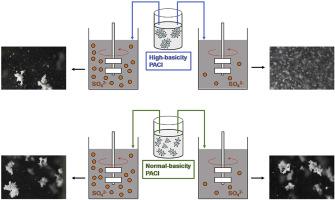Water Research ( IF 11.4 ) Pub Date : 2020-06-23 , DOI: 10.1016/j.watres.2020.116093 Yize Chen 1 , Yoshifumi Nakazawa 1 , Yoshihiko Matsui 2 , Nobutaka Shirasaki 2 , Taku Matsushita 2

|
Many PACl (poly-aluminum chloride) coagulants with different characteristics have been trial-produced in laboratories and commercially produced, but the selection of a proper PACl still requires empirical information and field testing. Even PACls with the same property sometimes show different coagulation performances. In this study, we compared PACls produced by AlCl3-titration and Al(OH)3-dissolution on their performance during coagulation-flocculation, sedimentation, and sand filtration (CSF) processes. The removal targets were particles of superfine powdered activated carbon (SPAC), which are used for efficient adsorptive removal of micropollutants, but strict removal of SPAC is required because of the high risk of their leakage after CSF. PACls of high-basicity produced by AlCl3-titration and Al(OH)3-dissolution were the same in terms of the ferron assay and colloid charge, but their performance in CSF were completely different. High-basicity Al(OH)3-dissolution PACls formed large floc particles and yielded very few remaining SPAC particles in the filtrate, whereas high-basicity AlCl3-titration PACls did not form large floc particles. High-basicity PACls produced by Al(OH)3-dissolution were superior to low-basicity PACl in lowering remaining SPAC particles by the same method because of their high charge neutralization capacity, although their floc formation ability was similar or slightly inferior. However, high-basicity Al(OH)3-dissolution PACl was inferior when the sulfate ion concentration in the raw water was low. Sulfate ions were required in the raw water for high-basicity PACls to be effective in floc formation. In particular, very high sulfate concentrations were required for high-basicity AlCl3-titration PACls. The rate of hydrolysis, which is related to the polymerization of aluminum species, is a key property, besides charge neutralization capacity, for proper coagulation, including formation of large floc particles. The aluminum species in the high-basicity PACls, in particular that produced by AlCl3-titration, was resistant to hydrolysis, but sulfate ions in raw water accelerated the rate of hydrolysis and thereby facilitated floc formation. Normal-basicity Al(OH)3-dissolution PACl was hydrolysis-prone, even without sulfate ions. Aluminum species in the high-basicity AlCl3-titration PACl were mostly those with a molecular weight (MW) of 1–10 kDa, whereas those of high-basicity Al(OH)3-dissolution PACls were mostly characterized by a MW > 10 kDa. Normal-basicity Al(OH)3-dissolution PACl was the least polymerized and contained monomeric species.
中文翻译:

原水中的硫酸根离子会影响由Al(OH)3溶解和碱滴定产生的高碱性PACl凝结剂的性能:通过凝结-絮凝,沉淀和砂滤除去SPAC颗粒。
许多具有不同特性的PACl(聚氯化铝)混凝剂已在实验室中试制并商业化生产,但是选择合适的PACl仍需要经验信息和现场测试。甚至具有相同特性的PACls有时也会表现出不同的混凝性能。在这项研究中,我们比较了由AlCl 3滴定和Al(OH)3溶解产生的PACls在混凝,絮凝,沉降和砂滤(CSF)过程中的性能。去除目标是超细粉状活性炭(SPAC)颗粒,用于有效吸附微量污染物,但由于CSF后其泄漏的高风险,因此需要严格去除SPAC。AlCl生成的高碱性PACl在铁氧测定和胶体电荷方面,3-滴定法和Al(OH)3-溶解度相同,但它们在CSF中的性能完全不同。高碱性Al(OH)3溶解的PACls形成大的絮状物颗粒,并在滤液中产生很少的残留SPAC颗粒,而高碱性AlCl 3滴定的PACls没有形成大絮状物颗粒。通过Al(OH)3溶解产生的高碱性PACls ,尽管它们的絮凝形成能力相似或稍差,但由于其高电荷中和能力,在通过相同方法降低残留的SPAC颗粒方面优于低碱性PACl。但是,高碱度的Al(OH)3当原水中的硫酸根离子浓度低时,PACL的溶解性差。高碱性PACls在原水中需要硫酸根离子才能有效形成絮凝物。特别是,对于高碱度的AlCl 3滴定的PACl ,需要非常高的硫酸盐浓度。水解速率与铝物质的聚合有关,是除电荷中和能力外的关键特性,它能适当凝结,包括形成大块絮状物。高碱度PACls中的铝物质,特别是通过AlCl 3滴定法生产的铝物质,具有抗水解性,但是原水中的硫酸根离子加速了水解速度,从而促进了絮凝物的形成。正碱性Al(OH)3-溶解PACl易于水解,即使没有硫酸根离子也是如此。高碱度AlCl 3滴定型PACl中的铝种类大多是分子量(MW)为1–10 kDa的那些,而高碱度Al(OH)3溶解型PACls中的铝种类主要是MW> 10 kDa。碱度正常的Al(OH)3溶解型PACl聚合得最少,并含有单体种类。











































 京公网安备 11010802027423号
京公网安备 11010802027423号